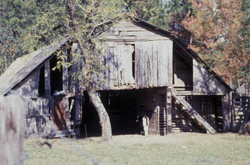Introduction to Delta Pieces: Northeast Louisiana Folklife
Map: Cultural Micro-Regions of the Delta, Northeast Louisiana

The Louisiana Delta: Land of Rivers








Ethnic Groups










Working in the Delta








Homemaking in the Delta



Worshiping in the Delta



Making Music in the Delta




Playing in the Delta







Telling Stories in the Delta



Delta Archival Materials
Bibliography


The French Delta
By Hiram Ford "Pete" Gregory, III
Editor's Note: In the early 1990s, Pete Gregory wrote these personal reflections about Northeast Louisiana's Delta and they are published with minimal editing. Also see his Musings on the Louisiana Delta from a Native Son.
As one moves south down the Mississippi River, the subtle signs of French Louisiana creep into the Delta scene. From the Mississippi's junction with the Red River, and the Atchafalaya River with the Mississippi, north and west the Delta received colonial French families. On the Red, Black, and Ouachita rivers, French families also took root. In the Catahoula and Concordia swamps, colonial French families, often mixed with Indian families, were already present by the 1780s. At Big Island, Deville, French Fork, Larto, Acme, and Eva, were enclaves of French families with their roots at the Rapides and Avoyelles posts.
By the 1830s, these families had been joined by Anglo-Americans from the Carolinas. They moved to Black River on barges bringing livestock, furniture, and farming equipment. Within a few years, the two cultures had fused to the point of not knowing who was which. Sansons, Belgards, Charriers, Chevaliers, Devilles, Pauls, Delhostes, and Pecanty (Picote) became kin to the Whites, Beards, Calhouns, Wileys, Mounts, Edwards, and Oneals. Their Catholic culture was Protestantized by Methodist circuit riders who worked the region in the 1800s, leaving converts everywhere. The distance from Catholic churches and the paucity of priests left Catholics without instruction, and the Carolinians brought their Protestant ways with them so the Baptists and Methodists won out. Only a handful of Catholics survived.
Material culture soon changed, too. On Black River, a unique blend of Creole houses and the Bluffland houses of southeastern Louisiana seem to dominate. Houses with a story-and-a-half, raised on piers off the ground, showing deep galleries front and back with outside stairs on the front, but with gable-end fire places, became a unique house type. In the 1950s, many of these old cypress structures stood along Black River, but now only a handful remain.
Similarly, the widespread use of cypress, a south Louisiana trait, began to diminish. The "pew" fence made of split cypress—derived from the French word pieux—was the first thing to go. Still a few "pew" pens, fences, and even outbuildings remain to be seen. The flat-bottomed boats, still called bateaux, were common along the rivers. Once a major vehicle of transportation, they have gradually become sporting goods. The cypress board boats have all but been replaced by aluminum versions.
Further up the Black/Ouachita, other little pockets of French families developed. At Hebert (He-bert in the English style) in Caldwell Parish, a few cling to Catholicism; but there, French and Anglo families are inextricably mixed again. Up the Boeuf River (it kept the French name) at Gilleyville, lots of French families struck out again. All these families were herders, fisherfolk and yeoman farmers.
At Monroe, the old colonial families became the equivalent of an aristocracy, eventually developing large plantations in ante-bellum days. The Pargouds, Breards, Marioneaux, and others still dominate some of the regional economies. Most of the families remain Catholic there in spite of two centuries of contact and intermarriage with local Anglo families, and French Creole cottages still dominate the older plantation architecture of the Monroe area.
French foodways are still common in the Delta. Dark black coffee dripped from freshly parched coffee beans dominates the whole of the Delta. Rice and gravy, mainly tomato gravy in the south and western portions of the Delta, are everywhere. Large biscuits, corn bread, "cracklin" bread, and lots of wild fruit jelly or cane syrup are typical noon meal favorites. "Bullets" of ground beef or highly seasoned garfish meat are clearly derived from French boulettes, a standard French cuisine.
Barbecue is an old Latin tradition in the Delta. Planters once cooked large amounts of meat (beef and pork) to feed their "hands" on the Fourth of July, when nobody had to work. Christmas and New Years were also vacation time with feasting and dancing. The Delta certainly differed from the hill country with its dancing, dance halls, and nightclubs, and love for the joie de vivre of their French ancestors.




